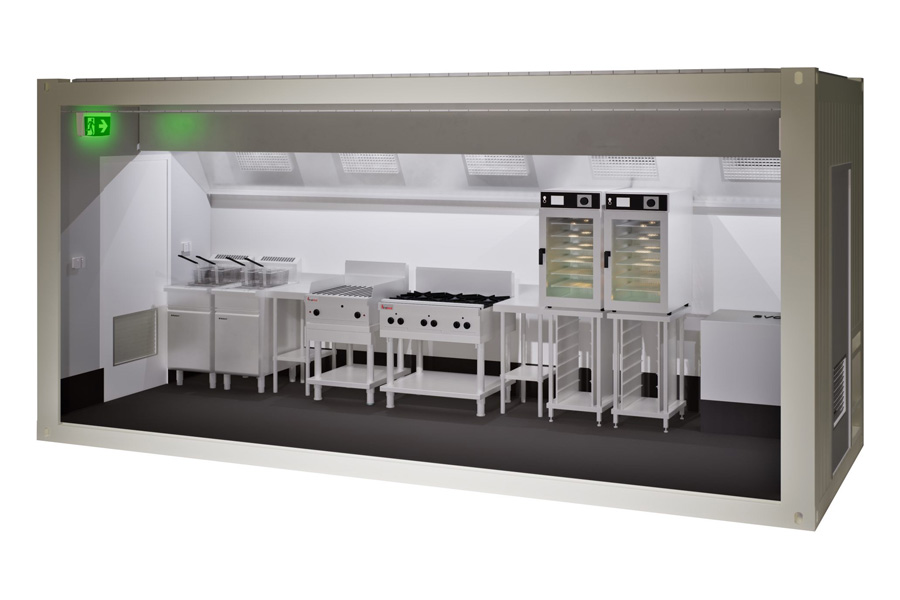When your permanent kitchen needs major renovations, disaster strikes, or you’re setting up temporary food service in remote locations, traditional solutions often fall short.
Marquees leak, equipment fails, and compliance becomes a nightmare.
Professional shipping container kitchens have emerged as the reliable solution for Australian businesses facing temporary kitchen challenges across multiple industries.
These aren’t converted containers with basic equipment thrown inside. They’re purpose-built FSANZ-compliant commercial facilities that arrive ready to handle everything from intimate corporate events to massive music festivals.
In this guide, you’ll learn how shipping container kitchens solve the three biggest challenges facing mobile caterers: compliance headaches, equipment limitations, and site restrictions.
You’ll also get real examples from operators who’ve made the switch and practical guidance for choosing the right solution for your business.
The numbers are compelling. Professional container kitchens bundle equipment, delivery, and setup into single predictable costs while delivering superior food safety compliance and operational efficiency.
Let’s explore exactly how these mobile facilities can solve your biggest catering challenges.
Key Takeaways
FSANZ compliance built-in:
Professional container kitchens arrive with full food safety compliance, eliminating health inspection worries and regulatory headaches.
Significant cost savings:
Mobile container kitchens eliminate multiple rental fees, delivery charges, and setup labour costs associated with traditional temporary equipment.
Professional equipment standards:
These units feature the same commercial-grade appliances found in permanent restaurant kitchens, not compromised temporary alternatives.
Rapid deployment anywhere:
From remote mining sites to urban rooftops, container kitchens operate in locations where traditional catering setups fail.
Scalable modular design:
Connect multiple units to handle everything from intimate events to massive festivals, with separate zones for prep, cooking, and cleaning.
Business continuity solution:
Keep operations running during renovations, emergencies, or equipment failures without losing revenue or dispersing staff.
What Makes Shipping Container Kitchens Different
Walk into a quality shipping container kitchen and you’ll immediately notice one thing: it doesn’t feel temporary.
These are fully-equipped commercial kitchens that happen to be housed in repurposed shipping containers.
The key word here is “repurposed” — these aren’t basic containers with equipment bolted inside.
Specialist manufacturers like Mobile Kitchens completely rebuild the interior to create purpose-designed food production facilities.
The difference shows in the details:
- Proper coved flooring that meets AS/NZS 4586 anti-slip standards.
- Stainless steel work surfaces throughout.
- Commercial-grade ventilation systems with variable speed exhaust canopies.
- Walk-in refrigeration units that maintain consistent temperatures even in 40°C heat.
- Most importantly for Australian operators: built-in FSANZ compliance.
Every element — from hand wash stations to floor drainage — meets Food Standards Australia New Zealand requirements.
No guesswork, no last-minute scrambling when the health inspector arrives.
The real test?
I’ve watched health inspectors walk through these units expecting to find shortcuts and compromises. Instead, they find facilities that often exceed permanent kitchen standards.
Why Traditional Temporary Kitchens Fall Short
Anyone who’s attempted large-scale catering with traditional temporary setups knows the frustration.
You’re juggling multiple equipment suppliers, each with different delivery schedules.
The refrigeration trailer arrives late.
The generator isn’t powerful enough for the cooking equipment.
The tent flooring becomes a safety hazard the moment someone spills water.
Then there’s the compliance nightmare.
Trying to create food-safe workflows in a space never designed for commercial cooking.
Hand Wash stations that don’t meet regulations.
Inadequate lighting that creates dangerous blind spots during busy service periods.
The hidden costs multiply fast. Equipment rental. Transport for each item. Setup labour. Additional insurance for non-compliant temporary structures. Most operators grossly underestimate the true cost until they’re committed to the job.
Shipping container kitchens solve these problems with a single delivery. Everything arrives together, tested and ready to connect to services.
Real-World Applications Across Australian Industries
Container Kitchens Use Cases:
Festival and Event Catering
Music festivals present unique challenges for food service.
Remote locations, massive crowds, strict time constraints. Traditional setups simply can’t handle the scale and intensity.
Major Australian festivals like Splendour in the Grass and the Byron Bay Blues Festival require facilities that can handle thousands of meals daily in locations with minimal permanent infrastructure.
Container kitchens provide the professional-grade capabilities needed for this scale of operation.
Festival operators use multiple connected units to create separate zones: hot food preparation, cold preparation, dishwashing, and storage.
Each unit handles specific functions while maintaining proper food safety workflows.
Emergency Catering When Permanent Facilities Fail
Kitchen fires, flood damage, equipment breakdowns — disasters don’t wait for convenient timing.
A Sunshine Coast aged-care facility faced this reality when its main kitchen suffered severe fire damage. They needed to continue serving 200+ meals daily while permanent repairs took place over six months.
A shipping container kitchen complex was delivered within 48 hours. Positioned in the facility’s car park, it maintained full meal production throughout the renovation period.
Residents barely noticed the disruption, and the facility avoided costly external catering contracts.
Remote Location Challenges
Australia’s mining and construction sectors regularly operate in locations with zero infrastructure.
Getting quality food to remote crews becomes a major logistical challenge.
Container kitchens excel in these environments. They’re built to handle harsh conditions while maintaining professional cooking capabilities.
A Western Australian mining operation reported that their container kitchen setup actually improved crew satisfaction compared to their previous permanent facility — better equipment, better ventilation, and more thoughtful workflow design.
Business Continuity During Renovations
Restaurant and hotel renovations can shut down operations for months. Lost revenue and dispersed staff often prove more costly than the renovation itself.
Smart operators use shipping container kitchens to maintain service during major upgrades. They position units in car parks or adjacent areas, connect services, and continue trading with minimal menu modifications.
A Brisbane hotel manager explained: “Our guests barely knew we were renovating. The container kitchen let us maintain our restaurant service and functions throughout a four-month kitchen upgrade. The alternative would have been closing completely.”
Technical Specifications That Matter
Equipment Standards
Quality shipping container kitchens feature commercial-grade equipment identical to permanent installations:
- Combi steamer ovens for precise cooking control
- Twin basket deep fryers with proper filtration
- 8-burner ranges with fan-forced ovens
- 300mm flat grill plates for high-volume cooking
- Pass-through dishwashers for efficient warewashing
- Walk-in cold rooms maintaining 0-4°C temperatures
This isn’t domestic equipment pretending to be commercial. These are the same brands and models you’d install in a permanent restaurant kitchen.
Power and Utilities
Modern units require 3-phase power for full operation. Most draw 63-100 amps depending on equipment configuration.
Quality providers ensure electrical systems can handle simultaneous operation of all equipment without circuit overloads.
Water consumption typically ranges from 500-1000 litres daily depending on menu complexity and volume.
Waste water systems connect to standard commercial drainage or holding tanks for locations without sewer access.
Safety and Compliance Features
Professional units include comprehensive safety systems:
- Emergency gas shutoff valves for safety compliance
- Wet chemical fire suppression systems for cooking equipment
- ABE-rated fire extinguishers positioned throughout
- Emergency lighting systems with battery backup
- Non-slip flooring rated to R12 standards
- Dedicated hand wash stations with proper compliance features
These features aren’t optional extras — they’re essential for insurance coverage and health department approval.
Choosing Between Rental and Purchase
When Rental Makes Financial Sense
Most Australian caterers benefit from rental arrangements, particularly for:
- Seasonal operations with periods of low activity
- Testing new markets or service types
- Project-based work with defined timelines
- Operations wanting to preserve capital for other investments
Rental costs vary significantly based on unit size, equipment specifications, and hire duration. Longer commitments typically offer better daily rates than short-term arrangements.
Purchase Considerations
Buying becomes attractive for operations with consistent, year-round demand.
Purchase costs vary significantly based on size, equipment specifications, and customisation requirements.
Basic units cost considerably less than fully-equipped large configurations with premium appliances.
Financing options exist, and quality units retain value well.
Some operators purchase for their core operations while renting additional capacity for peak periods.
Hidden Costs to Consider
Both rental and purchase involve additional expenses often overlooked:
- Site preparation and levelling
- Utility connections and disconnections
- Council permits and approvals
- Additional insurance coverage
- Cleaning and maintenance between uses
Reputable suppliers provide detailed cost breakdowns including these items rather than surprising clients later.
Site Requirements and Logistics
Ground Conditions
These units weigh 8-15 tonnes when fully equipped. Sites need:
- Level ground capable of supporting distributed weight
- Access for 12-metre delivery trucks
- Clearance for crane positioning (if required)
- Minimum 3-metre clearance around units for safety and maintenance
Soft ground or steep slopes require additional preparation, adding cost and complexity.
Utility Connections
Professional installations require:
- 3-phase electrical supply (63-100 amp capacity)
- Potable water connection (minimum 25mm diameter)
- Waste water drainage or holding tank access
- Gas supply (if specified) with appropriate pressure and flow rates
Distance from utilities to kitchen position affects connection costs. Units positioned more than 50 metres from services typically require additional infrastructure.
Council Approvals
Requirements vary dramatically between jurisdictions.
Some councils treat these as temporary equipment requiring minimal paperwork. Others demand full development applications with engineering reports.
Early consultation with local authorities prevents delays and unexpected requirements. Experienced suppliers often have established relationships with councils across their service areas.
Maximising Your Investment
Staff Training and Workflows
Portable kitchens require workflow adaptations compared to permanent facilities. Successful operators invest time training teams on:
- Equipment operation and safety procedures
- Modified prep and service sequences
- Emergency procedures specific to mobile facilities
- Cleaning and maintenance requirements
Well-trained teams adapt quickly and often prefer the modern equipment found in quality container kitchens.
Menu Optimisation
Smart caterers modify menus to suit container kitchen capabilities. This doesn’t mean compromising quality — it means working with the equipment’s strengths.
Focus on dishes that use the available cooking methods effectively.
Take advantage of combi oven precision for consistent results.
Plan prep sequences around available bench and storage space.
Maintenance and Cleaning
Regular maintenance keeps equipment operating efficiently and extends service life.
Quality rental providers handle major maintenance, but daily cleaning and basic upkeep remain your responsibility.
Establish cleaning schedules that prevent buildup of grease and food residue.
Pay particular attention to ventilation systems — proper airflow is essential for both comfort and compliance.
The Economics of Professional Mobile Catering
Cost Comparisons
Traditional temporary setups often cost more than operators expect:
- Equipment rental from multiple suppliers
- Individual delivery charges for each item
- Extended setup and breakdown labour
- Additional insurance for non-compliant structures
- Higher risk of equipment failure and replacement costs
Modular kitchens bundle these expenses into predictable packages with single-point responsibility.
Revenue Opportunities
Mobile kitchens open markets previously difficult to access:
- Remote corporate events with premium pricing
- Multi-day festivals requiring consistent food service
- Emergency catering contracts with government and large organisations
- Pop-up restaurant concepts in high-traffic locations
The ability to bring restaurant-quality facilities anywhere expands your potential client base significantly.
Business Model Flexibility
Container kitchens support various business approaches:
- Core catering operations supplemented by additional rental units during peak periods
- Specialist event catering focused on unusual or challenging locations
- Franchise or licensing models where container kitchens enable rapid expansion
- Emergency response catering for disaster relief and business continuity
This flexibility helps weather economic downturns and capitalise on growth opportunities.
Industry Trends and Future Outlook
Sustainability Focus
Container kitchens align with growing environmental consciousness.
Repurposing shipping containers reduces waste while their mobility means they can be redeployed rather than demolished when needs change.
Energy-efficient equipment and proper insulation reduce operational environmental impact compared to temporary structures with poor thermal performance.
Technology Integration
Modern units increasingly feature:
- Digital temperature monitoring with remote alerts
- Energy management systems optimising power consumption
- Integration with point-of-sale and inventory management systems
- Remote diagnostics for preventive maintenance
These technologies improve operational efficiency while reducing the skill level required for basic operation.
Market Growth
Demand for mobile food service solutions continues expanding across multiple sectors.
Healthcare, aged care, construction, mining, and events all show growing interest in professional mobile catering capabilities.
Supply is responding with more sophisticated units and expanded service networks. What was once a niche solution is becoming mainstream commercial practice.
Making the Right Choice for Your Business
Assessing Your Needs
Start with honest evaluation of your current operations:
- How often do you need mobile catering capabilities?
- What types of events and locations do you target?
- What’s your current cost for temporary kitchen setups?
- How much business do you turn away due to site limitations?
These answers guide whether rental, purchase, or continuing with traditional methods makes most sense.
Evaluating Suppliers
Not all container kitchen providers offer equivalent quality or service. Key evaluation criteria include:
- FSANZ compliance documentation and health inspection records
- Equipment specifications and age
- Maintenance programs and emergency support
- Insurance coverage and liability protection
- Geographic coverage and delivery capabilities
Planning for Success
Successful container kitchen adoption requires:
- Staff training on new equipment and workflows
- Menu modifications that play to the equipment’s strengths
- Site evaluation and utility planning for target venues
- Marketing that highlights new capabilities to potential clients
Professional Mobile Catering Solutions
Shipping container kitchens represent more than just equipment — they’re complete business capability upgrades.
They solve compliance challenges, equipment limitations, and site restrictions that constrain traditional mobile catering.
The Australian catering industry has embraced these solutions because they work. They deliver professional results in challenging conditions while reducing costs and complexity compared to traditional temporary setups.
For catering businesses ready to expand their capabilities or improve their existing mobile operations, shipping container kitchens from suppliers like Mobile Kitchens offer proven solutions backed by nationwide service and support.
The question isn’t whether mobile container kitchens make sense for modern catering operations.
The question is whether your business can afford to continue operating without them while competitors gain the advantages these solutions provide.
Professional mobile catering demands professional mobile facilities. Container kitchens deliver exactly that — anywhere in Australia.





